California, with its diverse array of habitats, serves as the home to approximately 42 species of lizards, some of which are invasive to the state. From the towering redwood forests and expansive deserts to serene grasslands, wetlands, and majestic mountain ranges, these unique landscapes nurture a vast range of wildlife, with lizards forming a key component of the state’s reptilian inhabitants.
As the most populated and one of the most biodiverse regions in the U.S., California hosts an incredible variety of lizards, each bearing its own distinguishing characteristics. This comprehensive guide provides an in-depth look at the lizards in California, detailing their appearances and pinpointing where to spot them.
Even though certain lizard species may appear strikingly similar, they often possess minute differences that set them apart. Given the expansive diversity within the reptile group — boasting over 6,000 species globally — the range of lizards is truly fascinating. So, let’s embark on this exciting exploration of all 42 lizard species that thrive in California, illuminating vital insights about these intriguing creatures.
Table of Contents
Lizards in California
Anniellidae
1. Norther Legless Lizard

- Experience Level: Beginner
- Family: Anniellidae
- Scientific Name: Anniella pulchra
- Other Names: California legless lizard
- Adult Size: 7 in. (18 cm.)
- Lifespan: 6 years
- Average Price Range: n/a
The California legless lizards range in California covers the central, and western coastal regions of the state. Habitats with loose soil, and sparse vegetation like desert scrubs, sandy washes, and chaparral are where these species live. They often hide under rocks or other natural debris. The San Joaquin County, and Sierra Nevada mountains are places this lizard is found.
California legless lizards have bodies similar to snakes. They have a slender body, with a shovel snout. Their body is silver, brown, or black. Their bellies can be yellow, or white. A dark line runs down this lizard’s sides.
Active during the day, this lizard requires cool living conditions. They are not seen often since they live underground, in burrows. This species may emerge at night, and feed on small invertebrates.
Anguidae
2. Panamint Alligator Lizard
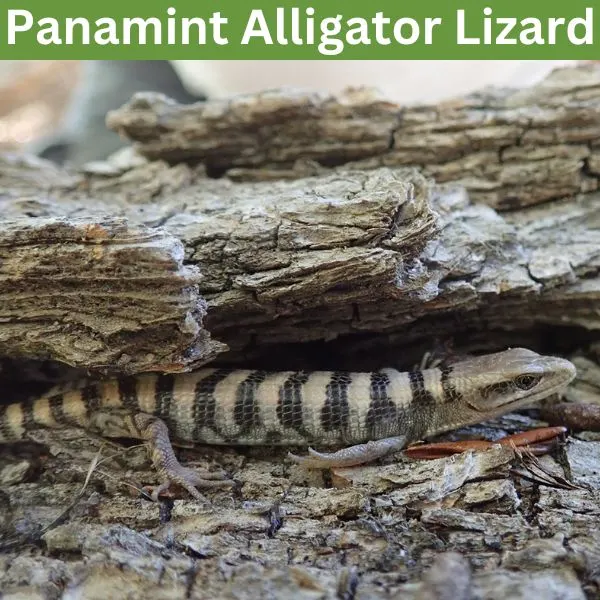
- Experience Level: Intermediate
- Family: Anguidae
- Scientific Name: Elgaria panamintina
- Other Names: n/a
- Adult Size: 2 to 5 in. (5 to 12.7 cm.)
- Lifespan: 7 years
- Average Price Range: n/a
The Panamint alligator lizard lives in riparian habitats and rocky regions. They are common near springs and freshwater river water sources. This species is common in desert habitats and grasslands. They are found in California within the Inyo, and Mono Counties, in the eastern part of the state.
Panamint alligator lizards have large heads, with elongated bodies. They have a striped pattern, with beige, yellow, or gray coloring. Their appearance helps them blend into trees, and their underside is pale.
These lizards are active during the day and enjoy climbing on things like rocks or trees. Their tail can break off to help defend themselves, similar to other lizards. Small invertebrates and insects are what this species eats.
3. Southern Alligator Lizard

- Experience Level: Intermediate
- Family: Anguidae
- Scientific Name: Elgaria multicarinata
- Other Names: n/a
- Adult Size: 3 to 7 in. (8 to 18 cm)
- Lifespan: 7 years
- Average Price Range: $350
The southern alligator lizards are found in most of California, but are absent from the northern regions of the state. Dry habitats near streams are where this species is common, but they are also found in places like forests. Southern alligator lizards have a stable population and are common in their range.
These lizards are very long, and including their tail can reach up to a foot in length. They have small limbs, with thick bodies. They have a grey, green, brown, or yellowish color. The scales of this species are keeled on their back.
Slugs, other lizards, and spiders are common foods for this species. They are common in suburban areas and are seen most breeding in the spring. Southern alligator lizards lay around two clutches a year, placing them in moist areas. They are common lizards sometimes seen in urban, and residential areas.
4. Northern Alligator Lizard

- Experience Level: Intermediate
- Family: Anguidae
- Scientific Name: Elgaria coerulea
- Other Names: n/a
- Adult Size: 10.8 in. (27.5 cm.)
- Lifespan: 7 years
- Average Price Range: $50
Northern alligator lizards are a species native to North America, and California. This lizard lives in woodlands, grasslands, and forest habitats. They are active in the day, and are not seen in cold periods. Northern alligator lizards may hide under rocks, and other debris when resting.
This lizard has a slender body, with short limbs. They have large heads, with long tails. Brown, olive, and gray are common colors this lizard appears on. They have a mottled pattern of cark markings covering them.
Northern alligator lizards feed on insect prey, and hunt both in the trees, and on the ground. They are most active from spring to fall, and breed during this period. Northern alligator lizards are common in their range, and have a stable population.
Chamaeleonidae
5. Jackson’s Chameleon
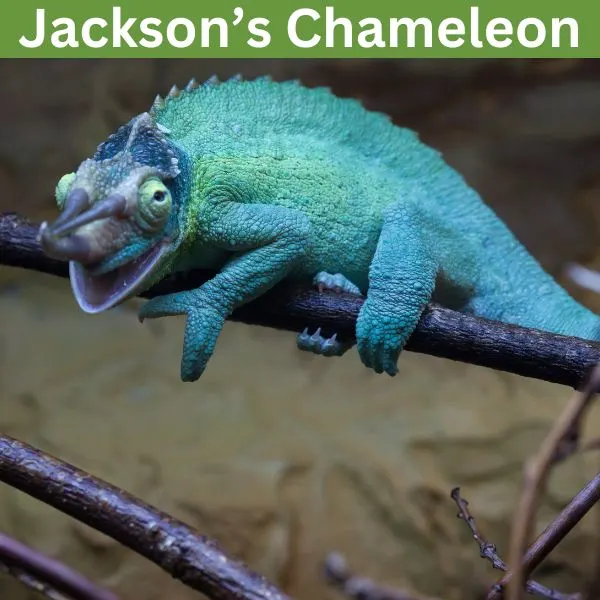
- Experience Level: Intermediate
- Family: Chamaeleonidae
- Scientific Name: Trioceros jacksonii
- Other Names: Three-horned Chameleon
- Adult Size: 10 to 12 in. (25.4 to 30.48)
- Lifespan: 5 to 10 years
- Average Price Range: $100
The jacksons chameleon is not native to California, but is a species that has been introduced. This lizard is very rare to find in the wilds of the state, and have been sighted in the San Luis Obispo, and Orange County areas near the coast. Jackson’s chameleons are native to Kenya, and Tanzania, living in mountainous, humid habitats.
Jackson’s chameleons that are male have three horns on their face, which are located on their brows, and nose. This lizard is medium-sized, with males also being slightly larger. Females have a shorter lifespan since laying eggs takes energy from them. This species has bright green coloring, with yellow undersides.
The pet trade is one of the main reasons these lizards become invasive. They are easy to keep pets if experienced and can be kept in an enclosure to mimic their habitat. Insects like crickets and fruit flies are what this species eats.
Crotaphytidae
6. Baja California Collared Lizard
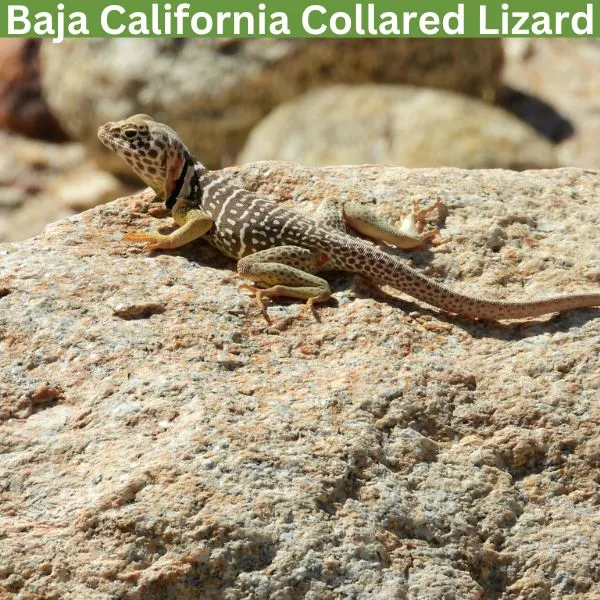
- Experience Level: Intermediate
- Family: Crotaphytidae
- Scientific Name: Crotaphytys vestigium
- Other Names: Baja black-collared lizard
- Adult Size: 2.7 to 4.4 in. (6.9 to 11.2 cm.)
- Lifespan: 8 years
- Average Price Range: n/a
The Baja California lizard is a species not seen often, living in rocky habitats. They are native to southern California and also found in Baja California Mexico. In some parts of this lizard’s range, they are protected, and not very common.
Baja California lizards are sexually dimorphic. Males have black patches on their throats and near their groin. Females have smaller heads and are less brightly colored. This species can be brown, or gray. They have a collar marking near their neck, with stripes, and blotches on their backs.
Insects, spiders, flowers, leaves, and smaller lizards are what this species eats. They breed in the summer and lay their eggs until fall. When running they are extremely quick and use their speed to escape predators. They are capable of running on two legs and are active during the day.
7. Desert Collared Lizard

- Experience Level: Intermediate
- Family: Crotaphytidae
- Scientific Name: Crotaphytus bicinctores
- Other Names: Great Basin collared lizard
- Adult Size: 10 in.(25.4 cm)
- Lifespan: 5 to 8 years
- Average Price Range: $50
The desert collared lizard is native to the western United States. They live in rocky, and desert habitats. This species is found in the Mojave, Sonoran, and Great Basin deserts of North America. In the California desert, collared lizards live in the eastern half of the state from the north to the south.
Desert collared lizards are named after the black marking around their necks that look like a collar. This species has tan, yellow, orange, and dark brown coloring on them. Stripes and blotches appear on their bodies. Males are more brightly colored than females of this species.
Desert collared lizards have strong jaws which are used to eat prey like insects, spiders, small lizards, and rodents. This lizard’s population is considered stable, and they are listed as a species of “least concern by the IUCN. They are active in the day, and their camoflauge in the desert vegetation, and rocks.
8. Cope’s Leopard Lizard

- Experience Level: Intermediate
- Family: Crotaphytidae
- Scientific Name: Gambelia copeii
- Other Names: Baja California Leopard Lizard
- Adult Size: 3.1 to 5.5 in. (8 to 14 cm.)
- Lifespan: 5 years
- Average Price Range: n/.a
Cope’s leopard lizard is found in a small region within southern California, near the border of Mexico, Baja California. This species lives in coastal scrub, chaparral, and oak wood habitats. Copes leopard lizards are very rare in the United States and are mainly found in Baja California.
Medium in size, this lizard has grey, with yellowish coloring. They have a mottled, ashy appearance, with cross bars on their body. The belly of this lizard is white, and females will gain red markings on their undersides in the breeding season.
Cope’s leopard lizards are named after herpetologist, Edward Drinker Cope. They rely on their camouflage, and vegetation to hide in to escape predators. The spring and summer are when this lizard is active most, seen during the day.
9. Blunt-nosed Leopard Lizard

- Experience Level: Intermediate
- Family: Crotaphytidae
- Scientific Name: Gambelia sila
- Other Names: n/a
- Adult Size: 3.4 to 4.7 in. (8.6 to 19 cm.)
- Lifespan: 5 years
- Average Price Range: n/a
The blunt-nosed leopard lizard is native to California, found in the Central Valley, in places like the San Joaquin valley. This species is found in foothills and valley habitats. They enjoy open space, with habitats that have sparse vegetation.
Blunt-nosed leopard lizards are medium-sized, with triangular heads. They have grey, brown, or black coloring, with blotches, and bands on them. The underside of this species is pale. Their toes are long, and their skin is wrinkly and velvety. In hotter temperatures, the color of this lizard’s skin may lighten.
Blunt-nosed leopard lizards are active during the day and feed on insects and small invertebrates. They may bask in the sun, and avoid the hottest period of the day. Found at elevations of 2,600 feet and below, this lizard is not common and is considered endangered. Habitat destruction and fragmentation are why this species is losing its population.
10. Long-nosed Leopard Lizard

- Experience Level: Intermediate
- Family: Crotaphytidae
- Scientific Name: Gambelia wislizenii
- Other Names: n/a
- Adult Size: 3.25 to 5.75 in. (8.225 to 14.6 cm.)
- Lifespan: 5 to 8 years
- Average Price Range: $20
Long-nosed leopard lizards lives in semi-arid habitats like grasslands, and creosote bush. They do not like densely vegetated areas and live at elevations up to 6,000 feet above sea level. Desert and foothill habitats are where this species is most common. The southeastern corner of the United States is where this species is primarily found in California.
This lizard is named after the leopard-like markings that appear on them. They have yellowish, or tan coloring, with spots, and crossbars. When young this species has brighter colors.
Long-nosed leopard lizards are fast and active during the day. They are active mostly in spring, to fall, and when not active hide under rocks, or burrows. Long-nosed leopard lizards are capable of eating lizards their own size but mainly feed on insects.
Helodermatidae
11. Gila Monster

- Experience Level: Advanced
- Family: Helodermatidae
- Scientific Name: Heloderma suspectum
- Other Names: n/a
- Adult Size: 10.2 to 14.1 in. (26 to 36 cm)
- Lifespan: 20 to 36 years
- Average Price Range: $1,200
The Gila monster is the largest lizard in California, and are found in a small section within southeastern California. Gila monsters in California are rare. They live in desert scrub and semi-desert habitats. Not seen often, they spend most of their lives in underground burrows. Spring is when this species is spotted most, and they come out early in the morning.
Gila monsters have orange and black coloring, with a blotched or banded pattern. They have robust bodies, with beaded scales. Their limbs are short, and keep their bodies low to the ground.
Gila monsters are the only venomous lizard in California. They have grooved teeth to administer venom, which causes pain, a drop in blood pressure, chills, and other symptoms. There have been no deaths from this lizard’s bite, and bites overall are rare since this lizard does not come in contact with humans often.
Iguanidae
12. Common Chuckwalla

- Experience Level: Intermediate
- Family: Iguanidae
- Scientific Name: Sauromalus ater
- Other Names: n/a
- Adult Size: 16 in. (40 cm.)
- Lifespan: 15 to 65 years
- Average Price Range: $200
Common chuckwallas are found in the southeastern corner of California. These lizards live in rocky hillsides and desert habitats. They are active most from spring to summer and spend this time breeding. Females can lay up to 16 eggs, which hatch in the fall. These lizards’ range covers the southwestern United States and parts of Mexico.
Common chuckwallas are one of the largest lizards in California. They have large bodies, with round bellies. They can be brown, black, tan, or reddish. Their bodies are sometimes different colors than their heads. This lizard may have a banded, or speckled pattern on the. Their skin is wrinkly.
The common chuckwalla is a secretive lizard that hides in crevices, and flees when spotted. They are active in the day, and in the colder months take shelter in a burrow. These lizards are harmless to humans, and were actually used as food for the indigenous people that lived in North America.
13. Desert Iguana

- Experience Level: Intermediate
- Family: Iguanidae
- Scientific Name: Disposaurus dorsalis
- Other Names: n/a
- Adult Size: 16 inches (40 cm.)
- Lifespan: 10 to 16 years
- Average Price Range: $50
The desert iguana is a species found in the southeastern regions of California. Desert flats, floodplains, rocky regions, and sandy habitats are places where this lizard lives. They have a high tolerance to heat and are active even in the hottest times of the day. In the winter, or when resting this species will take shelter in a burrow.
Desert iguanas are a large species, with small heads, and blunt noses. They have beige, gray, or brown coloring. They have yellowish, or red markings like spots and bands on them. Their tails are long, and their underside is pale.
Desert iguanas breed in the summer and lay around 3 to 8 eggs. They begin to hatch in the fall, before hibernating in the winter. Fruits, flowers, insects, and small invertebrates are what this lizard eats. They are common food for animals like foxes, rodents, snakes, and birds.
Lacertidae
14. Italian Wall Lizard

- Experience Level: Beginner
- Family: Lacertidae
- Scientific Name: Podarcis siculus
- Other Names: Ruin lizard
- Adult Size: 3.5 in. (9 cm.)
- Lifespan: 13 years
- Average Price Range: n/a
The Italian wall lizard is an invasive species in California. This lizard is extremely rare in the state and has only been found in the San Pedro, and San Diego regions. Fields, woodlands, and urban areas are the habitats these lizards live in.
Italian wall lizards have brown, green, or black coloring. They have long toes, with pointed heads, and long tails. Dark blotches appear on this lizard’s skin, and its scales are mildly keeled. The tail of this species is typically brown, while their bodies are green.
These lizards feed on anything they find that is small enough to fit in their mouth. They may eat small insects, but also lizards if they are capable of catching them.
Phrynosomatidae
15. Common Side-blotched Lizard

- Experience Level: Beginner
- Family: Phrynosomatidae
- Scientific Name: Uta stansburiana
- Other Names: n/a
- Adult Size: 2.5 to 5 inches (6.35 to 12.7 cm.)
- Lifespan: 1 year
- Average Price Range: $12
The western United States, including California is where the common side-blotched lizard is native to. In California, this species has a large range covering most of the lower south, and central regions of the state. Dry, desert, and scrub habitats are where this species lives.
Common side-blotched lizards get their name from the marking on their side. This species has yellow, tan, or brown coloring. They can have blue and yellow specks on them, and their scales are roughly keeled. The neck of this lizard can have a yellow, or blueish hue.
This species is known for its mating and the differences that males showcase. Males can have a yellow, orange, or blue throat. Yellow-throated males use the sneaking method to find a mate, while blue-throated males are more dominant. The orange-throated males are the most dominant, and aggressive when mating, and each method has its advantage in allowing males to reproduce successfully.
Small insects and spiders make up the majority of this lizard’s diet. They have a variety of predators like birds and snakes. Common side-blotched lizards are extremely quick and use their speed to escape enemies.
16. Ornate Tree Lizard

- Experience Level: Beginner
- Family: Phrynosomatidae
- Scientific Name: Urosaurus ornatus
- Other Names: n/a
- Adult Size: 1.49 to 2.32 inches (3.8 to 5.9 cm)
- Lifespan: 3 years
- Average Price Range: n/a
Ornate tree lizards are a species native to California, and they are found in the far southeastern border of the state, of the state. Ornate tree lizards are semi-arboreal, and live in riparian, oakwood, and mesquite type habitats.
Ornate tree lizards are medium-sized and have tan, or grayish coloring. They have dark brown, or black markings on them, and their coloring helps them blend into tree bark. The tails of these lizards are roughly keeled, and males have a turquoise coloring under their neck. Ornate tree lizards come in various color morphs, with some having orange, or blue markings on them.
Insects, and larvae is what this lizard mainly eats, but they may also eat on plant materials like fruit. The colors of this lizard may determine their speed, how they breed, and how aggressive they are. Ornate tree lizards have a very small range in California, but overall their population is considered stable.
17. Long-tailed Brush Lizard

- Experience Level: Intermediate
- Family: Phrynosomatidae
- Scientific Name: Urosaurus graciosus
- Other Names: n/a
- Adult Size: 1.8 to 2.5 in. (4.7 to 6.6 cm)
- Lifespan: 5 years
- Average Price Range: n/a
The long-taield brush lizard is native to the southwestern United States. This species is found in the Mojave Desert, and is found in the southeastern corner of California. Desert, and hot habitats with sparse vegetation is where this lizard lives. They are capable of being active in high temperatures, and are seen most from spring to fall.
Long-tailed brush lizards have gray, brown, or tan coloring. They have a very long tail, almost double the size of their body. Mottled markings cover this lizard, and they have a appearance that helps them camouflage into trees.
This species may be seen climbing rocks, or trees. During the day they hunt for small invertebrates, and sometimes eats flowers, or fruits. Long-tailed brush lizards like other lizards are able to detach their tail, and grow it back.
18. Yellow-backed Spiny Lizard

- Experience Level: Intermediate
- Family: Phrynosomatidae
- Scientific Name: Sceloporus uniformis
- Other Names: n/a
- Adult Size: 4 to 7 in. (10.16 to 17.78 cm.)
- Lifespan: 30 years
- Average Price Range: n/a
The yellow-backed spiny lizard is native to the Mojave, and Great Basin deserts in North America. In California, this lizard lives next to Nevada, on the southeastern border of the state. Yellow-backed spiny lizards live in semi-arid flats, plains, riparian, and mountainous habitats.
This lizard has a tan, or brown coloring, with a black coloring marking around its neck. Their scales are roughly keeled and their toes are long. A yellow and black mottled pattern covers this species.
Active during the day, this lizard spends its time hunting small invertebrates to eat. They bask in the sun to warm up, and when resting may hide in a burrow to avoid the heat.
19. Granite Spiny Lizard
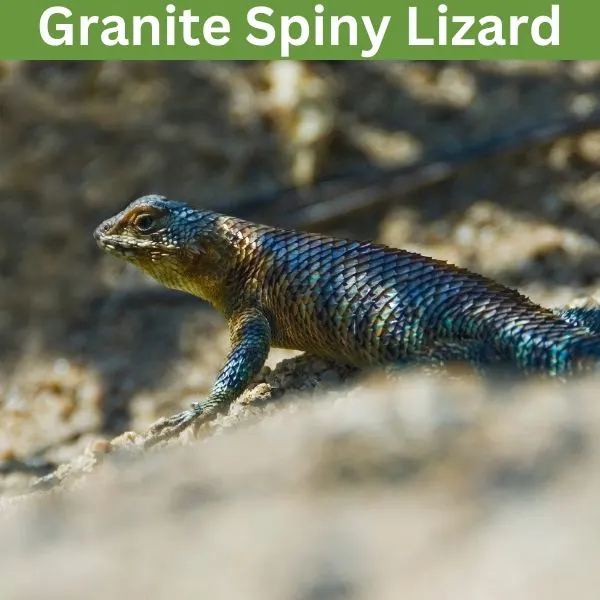
- Experience Level: Intermediate
- Family: Phrynosomatidae
- Scientific Name: Sceloporus orcutti
- Other Names: n/a
- Adult Size: 3 to 4.3 in. (7.6 to 10.8 cm)
- Lifespan: 2 to 7 years
- Average Price Range: n/a
Granite spiny lizards are native to California, found in the small region within the southern portion of the state. This species is mainly found in Baja California, but its range creeps into California. Granite spiny lizards live in granite cliffs and mesquite habitats.
This lizard is medium in size and has a brown, black, to coppery color. They have roughly keeled scales, and a purple stripe running down their body. Males have yellow, or greenish blue hue on their bodies.
Active during the day, you can sometimes spot these lizards basking on rocks. Their coloring and scales help them blend into granite. From spring to fall this species is active, and they spend their day feeding on insects, and plants.
20. Western Fence Lizard

- Experience Level: Intermediate
- Family: Phrynosomatidae
- Scientific Name: Sceloporus occidentalis
- Other Names: Blue-belly lizard
- Adult Size: 4 to 7.5 in. (10 to 19 cm.)
- Lifespan: 5 to 7 years
- Average Price Range: $20
In California, the western fence lizard is found all over the state but is absent from the state’s southeastern region. These lizards live in open, and sunny habitats. They can be found in woodlands, grasslands, and chaparral habitats near waters. Western fence lizards mate in early spring and lay their eggs in loose soil.
Western fence lizards have brown, gray, or black colors. They are covered in blotches, but some may appear all dark. Males have bright blue coloring on their throat, and more vibrant coloring on them overall. When young this species has little color, but as they age they may develop blue on their bellies.
The western fence lizard feeds on terrsatrial invertebrates like spiders, crickets, and other insects. They are active in the day, and enjoy basking on fences or rocks. The desctruction of this lizards habitat has caused them to adapt ot live in urban areas. Less scales, and shorter limbs are some of the way these lizards have changed.
21. Banded Rock Lizard
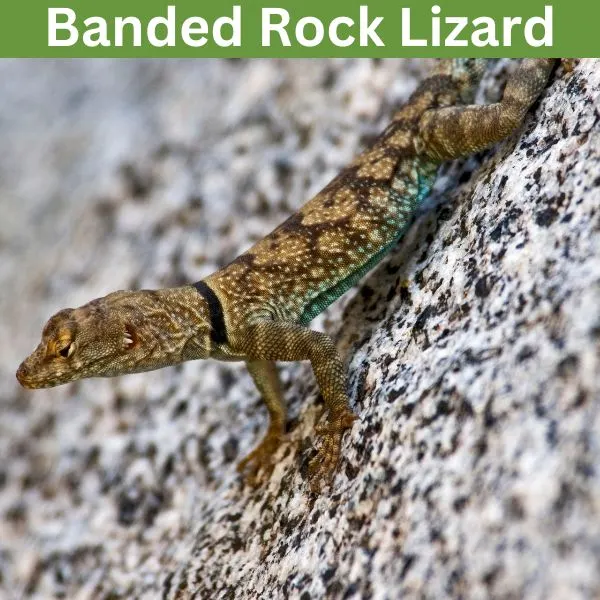
- Experience Level: Intermediate
- Family: Phrynosomatidae
- Scientific Name: Petrosaurus mearnsi
- Other Names: n/a
- Adult Size: 2.3 to 3.4 in. (6.2 to 8.7 cm.)
- Lifespan: 5 to 7 years
- Average Price Range: n/a
The banded rock lizard is native to North America, and found in a small region within southern California. This species lives in rocky canyon, desert, and mountains habitats. They have been found in the San Gorgonia Pass and the Peninsular Range mountains.
Banded rock lizards have olive, brown, or gray coloring. They have a mottled pattern on them, with bands on their tail. Their neck has a collar pattern, and their scales overall are very keeled.
This species feeds on insects, and plant materials. They are very rare due to their small range but have a stable population. This species breeds by laying eggs, having between 2 to 6 in the summer.
22. Zebra-Tailed Lizard

- Experience Level: Intermediate
- Family: Phrynosomatidae
- Scientific Name: Callisaurus draconoides
- Other Names: n/a
- Adult Size: 7 to 9 in. (17.78 to 22.86 cm.)
- Lifespan: 3 to 5 years
- Average Price Range: $15
Zebra-tailed lizards are found in the southwestern United States. This species is native to the Mojave and Great Basin deserts. In California, zebra-tailed lizards can be found in the southeastern portion of the state. Zebra-tailed lizards prefer open desert habitats, with little vegetation, and packed soil.
This lizard has a curled tail, which has a black and white banded pattern. They have grey, to sandy brown coloring. Dark spots appear on their back, and males can have blue patches on their bellies. A yellowish-mottled pattern covers them, and yellow coloring also appears on their legs.
Active in the day, this species gets up early to avoid the hottest time of day. They are capable of standing on two legs and are very quick to escape when threatened. The summer is when this species mates and they lay around 2 to 8 eggs. Birds, larger lizards, and small mammals are the predator’s zebra-tailed lizards face.
23. Mojave Fringe-toed Lizard

- Experience Level: Intermediate
- Family: Phrynosomatidae
- Scientific Name: Uma scoparia
- Other Names: n/a
- Adult Size: 3 to 7 in. (7.62 to 17.78 cm.)
- Lifespan: n/a
- Average Price Range: n/a
The Mojave fringe-toed lizard is found in southeastern California. This lizard is native to the Mojave Desert, found in arid sand dune habitats. The winter is when this lizard is not seen, as they hibernate during the coldest period. Mojave fringe toed lizards are found in elevations up to 3,000 ft.
This lizard has a flat body with smooth skin. They have a mottled pattern on them, and coloring ranging from white to tan. This species has crescent-shaped markings on its underside, and bands on its tail. The color of this lizard matches the desert habitats they live in.
Mojave fringe-toed lizards face predators like badgers, road runners, coyotes, and predatory birds. Invertebrates like insects and spiders are what this lizard eats. They have a stable population and are named after their fringed toes which help them travel in the sand.
24. Colorado Desert Fringe-toed Lizard
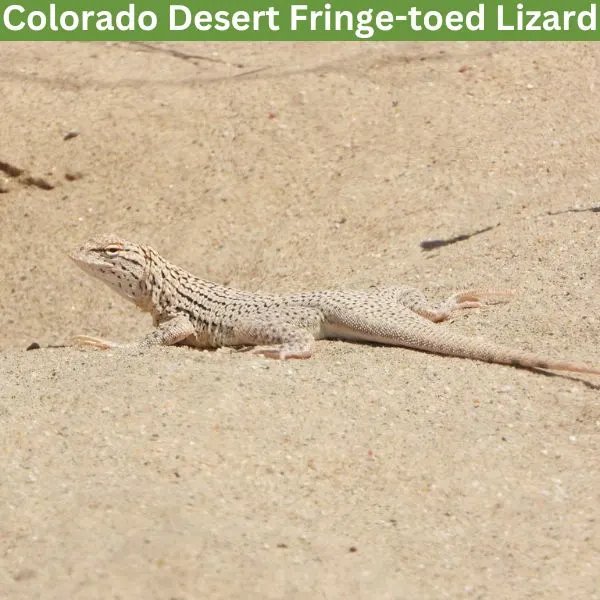
- Experience Level: Intermediate
- Family: Phrynosomatidae
- Scientific Name: Uma notata
- Other Names: n/a
- Adult Size: 4.5 in. (11 cm.)
- Lifespan: n/a
- Average Price Range: n/a
The Colorado desert fringe-toed lizard is found in the far southeastern regions of California. Semi-arid habitats with sparse vegetation are where this lizard prefers to live. They need sand, and loose soil to burrow. The Colorado Desert to the Salton Sea is where this lizard is found in the state.
Medium in size, this species has white, to tan coloring. They have a pale underside, with black bar markings on their tail. Dark brown and black stripes, with a mottled pattern, cover this lizard, and they have a flat body. The toes of these lizards are very long, and help them travel in their sandy habitats.
Colorado desert fringe-toed lizards blend into the sandy habitats they live in. This lizard is active during the day, and when not out spends their life in burrows. They feed on small invertebrates like ants but sometimes eat flowers or leaves. Breeding occurs in the spring, and they lay up to 4 eggs.
25. Coachella Valley Fringe-toed Lizard
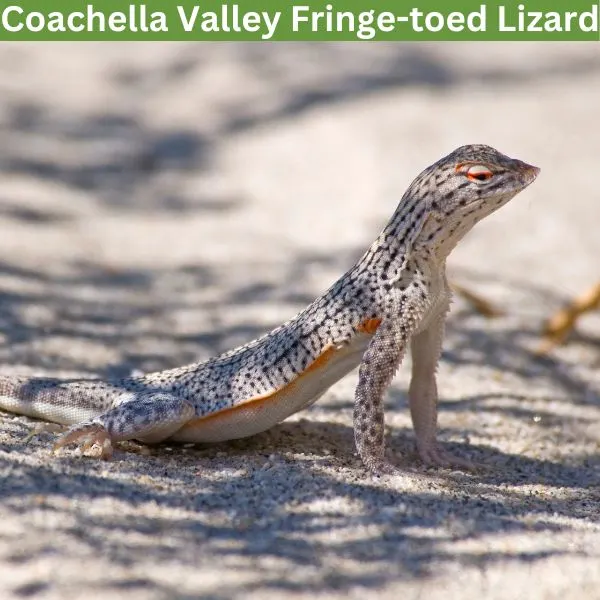
- Experience Level: Advanced
- Family: Phrynosomatidae
- Scientific Name: Uma inornata
- Other Names: n/a
- Adult Size: 6 to 9 in. (15.24 to 22.86 cm.)
- Lifespan: n/a
- Average Price Range: n/a
Coachella Valley fringe-toed lizards are native to California, and found in the Coachella Valley. This species lives in sparsely vegetated, and arid habitats. They need fine and loose soil, which they use to burrow.
Coachella Valley fringe-toed lizards have flat bodies and are medium-sized. This species has smooth skin, and its coloring helps them blend into the sandy desert habitat. This species has black and tan stripes on them, with a mottled pattern. They have white bellies, with black markings under their chin.
Active in the day, this lizard hibernates in November and becomes active again in February. They fed on ants, beetles, and other invertebrates. This lizard is considered endangered and has experienced a population decline of around 75%. They have become endangered due to habitat loss.
26. Blainville’s Horned Lizard
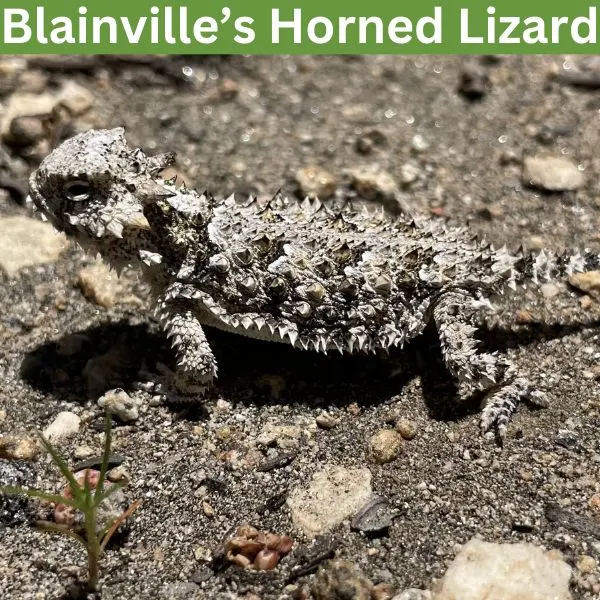
- Experience Level: Intermediate
- Family: Phrynosomatidae
- Scientific Name: Phrynosoma blainvilli
- Other Names: Sand Diego Horned Lizard
- Adult Size: 2.5 to 4.5 in. (6.3 to 11.43 cm.)
- Lifespan: 5 t o8 years
- Average Price Range: n/a
The Blainville’s horned lizard is native to California, found mainly in the western coastal regions of the state. This species lives in sandy habitats, foothills, grasslands, woodlands, and open areas with loose soils. They are active from spring to fall and mate during this period.
This lizard has a round body, with a flat appearance. Their color ranges from tan to dark brown, but may appear red when young. They have spikes on their head, and covering their body. A dark mottled and banded pattern covers them. The belly of this lizard is yellow, or beige, and smooth compared to the rest of its body.
Blainvilles horned lizards are active during the day. They use their spikes to make themselves harder to eat, and their spikes also help them blend into their environment. The day is when this species is active, and they retreat into burrows at night, and in cold temperatures.
27. Flat-tailed Horned Lizard

- Experience Level: Intermediate
- Family: Phrynosomatidae
- Scientific Name: Phrynosoma mcallii
- Other Names: n/a
- Adult Size: 3.4 in. (8.6 cm.)
- Lifespan: 3 to 8 years
- Average Price Range: n/a
The flat-tailed horned lizard is one of many of California’s native horned lizards. This species’ range is very small in the state, and only found in the extreme southeastern regions. Active in the day, this species is found in the Colorado desert. This lizard is considered near threatened, and has been under stress as a species from habitat loss.
Flat-tailed horned lizards are medium in size and have a flat, oval shape. This species has a smooth back, and flat tail. They have large spikes on their heads, with smaller ones on their sides. This lizard has tan, to dark brown coloring.
Their shade, and shape help this lizard blend into their habitats. Flat-tailed horned lizards have one of the smallest ranges of any horned lizard in North America, and their habitat needs to be protected to prevent further decline of this species.
28. Pygmy Short-horned Lizard

- Experience Level: Intermediate
- Family: Phrynosomatidae
- Scientific Name: Phrynosoma douglasii
- Other Names: n/a
- Adult Size: 1 to 3 in. (2.5 to 6.5 cm.)
- Lifespan: 10 years
- Average Price Range: n/a
Pygmy short-horned lizards are native to North America, and their range covers the northwestern region of the United States. This lizard has a small range in the southeastern region of California. Pygmy short-horned lizards live in sagebrush, and woodland habitats. They prefer places with lots of sandy soil.
This lizard has a round body, with small pointed scales covering them. They have a crown of spines on their heads, and have gray, yellow, or reddish brown coloring. The color, and spikes on this lizard help them blend into their sparsely vegeted habitats.
This lizard feeds on ants mainly, but may also eat other invertebrates they find. Pygmy short horned lizards have a stable population, and are listed as a species of least concern. Their scientific name honors the Scottish botanist David Douglas.
Scincidae
29. Western Skink
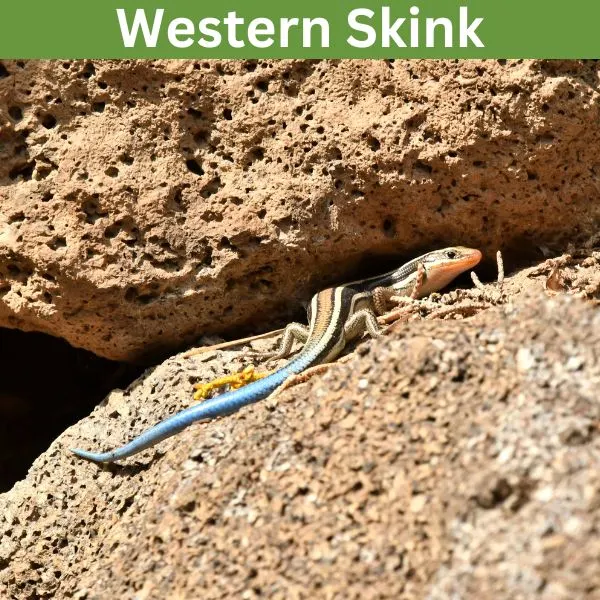
- Experience Level: Beginner
- Family: Scincidae
- Scientific Name: Plestiodon skiltonianus
- Other Names: n/a
- Adult Size: 4 to 8.25 in. (10.16 to 20.95 cm.)
- Lifespan: 10 years
- Average Price Range: n/a
The western skink in California has a large range, and they could be found in the upper northern region, and all along the coast. Western skinks prefer open habitats, and will typically avoid heavily forested areas. They are active from up to 7,000 ft. above sea level and are seen most during the warm season. Grasslands, woodlands, and chaparrals are where this lizard lives.
Western skinks when born have blue tails and also have more vibrant coloring. Western skins have tan coloring, with a dark stripe on their sides. They have pointed heads, with smooth scales. As this species ages, they become more gray in color.
Western skinks are active in the day, and face predators like small mammals, birds, and larger lizards. They hibernate in the winter and may live together in communal dens. Breeding for this species occurs in the spring, and they lay eggs around 2 to 6 eggs in the summer.
30. Gilbert’s Skink

- Experience Level: Beginner
- Family: Scincidae
- Scientific Name: Plestiodon gilberti
- Other Names: n/a
- Adult Size: 3 to 4.5 in. (7 to 12 cm.)
- Lifespan: 6 years
- Average Price Range: n/a
The gilberts skink has a scattered population in California, and they are native to the western United States. This species is found in San Joaquin Vally, until the foothills of Sierra Nevada, as well as the coastal mountains near San Francisco. Grasslands, open woodlands, and chaparral are the habitats this species lives in.
Gilbert’s skinks have a large body, with small legs. They have green, grey, brown, or olive color, and have a broad stripe on them when young. The scales of this species are smooth.
Places with heavy vegetated are areas this lizard usually avoids. They may hide under natural debris like leaves, logs, and rocks. This species feeds on small insects and other terrestrial invertebrates.
Gekkonidae
31. Mediterranean House Gecko
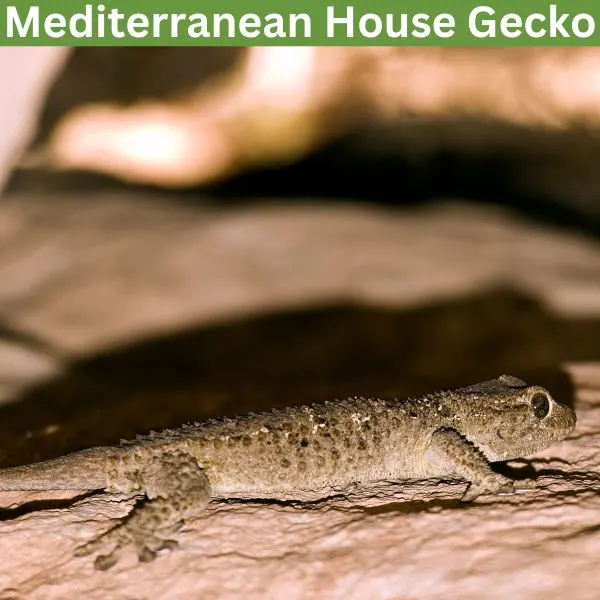
- Experience Level: Beginner
- Family: Gekkonidae
- Scientific Name: Hemidactylus turcicus
- Other Names: Turkish gecko
- Adult Size: 3 to 6 in. (7.62 to 15.24 cm.)
- Lifespan: 9 years
- Average Price Range: $10
The Mediterranean house gecko is not native to California, and as their name suggests are native to the Mediterranean. This lizard has a scattered population, and is found across California, but is not common. Urban habitats near man-made buildings are where this species lives. They are active at night and are found climbing on walls, and near lighting.
Mediterranean house geckos have tan to cream coloring. They have a mottled pattern covering them, with bumpy skins. This gecko has yellow, elliptical eyes. They have vertical pads on their fingers, used to help them climb.
Mediterranean house geckos feed mainly on insects, hunting for them near light sources. They have managed to travel to new areas by traveling on ships and being released into the wild by owners who kept them as pets. The excellent eyesight is how this lizard finds its prey, and they will also feed on dead invertebrates.
32. Western Banded Gecko

- Experience Level: Beginner
- Family: Gekkonidae
- Scientific Name: Coleonyx variegatus
- Other Names: n/a
- Adult Size: 4 to 6 in. (10 to 15 cm)
- Lifespan: 5 to 8 years
- Average Price Range: $60
The western banded gecko is found in southern California, and other regions in the southwestern United States. This species lives in woodlands and desert habitats. They live up to elevations up to 4,990 ft. Rocky places with lots are sand are places where they prefer to live.
Western banded geckos are medium in size. They have a purplish, and yellow coloring, with blotches, and bands on them. Small scales covering this lizard give them a smooth look. They have large eyes, with blinkable eyelids, that are yellow, and elliptical.
Active at night, this lizard mainly feeds on insects, and other invertebrates like scorpions. They are very quick, and use their speed to escape predators like foxes, and snakes.
Eublepharidae
33. Barefoot Banded Gecko

- Experience Level: Intermediate
- Family: Eublepharidae
- Scientific Name: Coleonyx switaki
- Other Names: Switaks Banded Gecko
- Adult Size: 2 to 3.4 in. (5.1 to 8.6 cm)
- Lifespan: 5 years
- Average Price Range: n/a
The barefoot banded gecko lives in the far southeastern United States. This species lives in semi-arid canyons, and hilly scrub habitats. In California, the barefoot banded gecko has a very small range and is found in the Peninsular ranges.
Barefoot banded geckos are small, with a triangular head. They have light gray, tan, yellow, or dark brown coloring. Spots and a banded pattern covers this species. Their tails have bands, with black and white coloring on them.
The small size and population of this species make them difficult to study. This lizard is able to break off its tail in case attacked and grow them back. Barefoot-banded geckos feed on small invertebrates. Their species’ name is in honor of the German herpetologist Karl-Heinz Switak.
Phyllodactylidae
34. Moorish Gecko

- Experience Level: Intermediate
- Family: Phyllodactylidae
- Scientific Name: Tarentola mauritanica
- Other Names: Crocodile Gecko, Common Wall Gecko
- Adult Size: 5.9 in. (15 cm.)
- Lifespan: 15 years
- Average Price Range: $30
The Moorish gecko is native to the western Mediterranean region, and are an invasive lizard in California. This lizard is very rare in California, and found in a few counties near the coast of the state. Moorish geckos live in urban areas, and are active in the warm season.
Moorish geckos are medium-sized and have thick bodies. They have a tan, to black coloring, with roughly keeled scales on them. When active in the day this lizard has dark coloring. Large toe pads appear on their feet to help them climb.
The night is when Moorish geckos are typically active, and they spend their night feeding on small invertebrates. The pet trade and people releasing this lizard into the wild are how they could have made their way to California.
35. Peninsular Leaf-toed Gecko
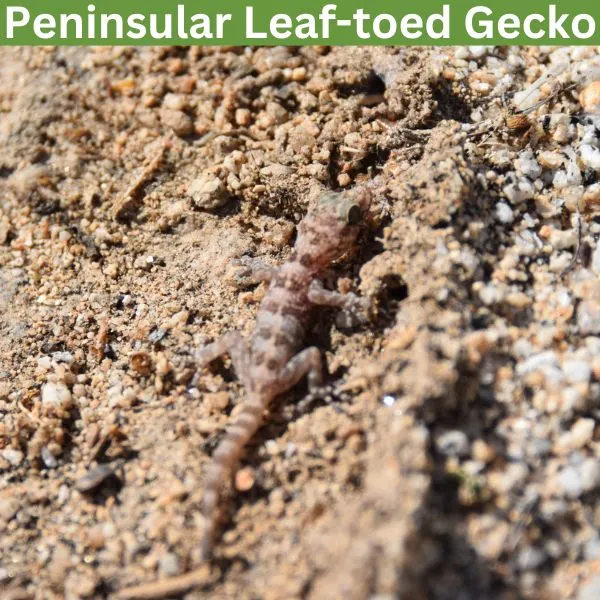
- Experience Level: Intermediate
- Family: Phyllodactylidae
- Scientific Name: Phyllodactylus nocticolus
- Other Names: n/a
- Adult Size: 2 to 3.3 in. (5 to 8.4 cm.)
- Lifespan: 15 years
- Average Price Range: n/a
Southern California is where the peninsular leaf-toed gecko lives. This species lives in desert, and shrub habitats with lots of rocks. They are only found in a small region of California, near the Anza-Borrego desert state park.
This species is very small, with purplish, to tan coloring. They have yellow elliptical eyes, with a dark mottled pattern covering them. The limbs of this lizard are very small. The pattern and coloring of them help them blend into their rocky environments.
Penusiular leaf-toed geckos feed on termites, ants, flies, and other small invertebrates. They breed in the spring and lay around 1 to 2 eggs. The night is when this lizard comes out, and their small range and secretive nature make them rarely seen.
Teiidae
36. Orange-throated Whiptail
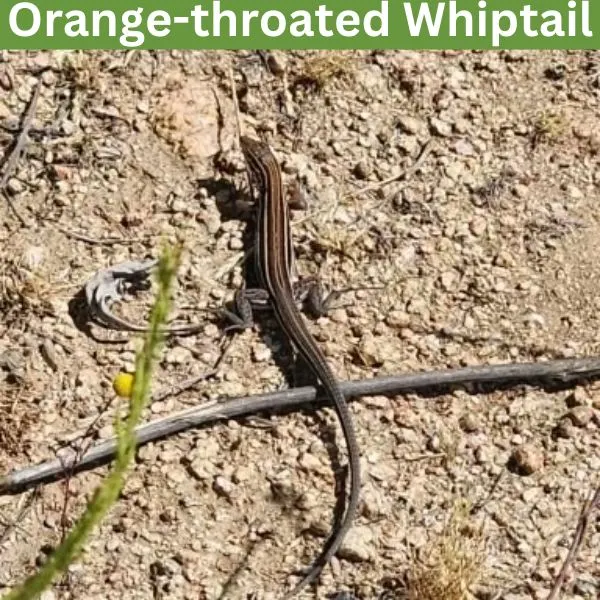
- Experience Level: Intermediate
- Family: Teiidae
- Scientific Name: Aspidoscelis hyperthrus
- Other Names: n/a
- Adult Size: 2 to 2.8 in. (5 to 7.2 cm.)
- Lifespan: 7 years
- Average Price Range: $10
The orange-throated whiptail is found in California near the southwestern coastal region of the state. Baja California is where the majority of this lizard’s range lies. Semi-arid habitats with loose soil, and streams nearby are where this lizard prefers to live.
Orange-throated whiptails are named after the orange coloring on this species’ chest, and throat that appears on them in the breeding season. This species has brown, black, or olive coloring. They have yellowish lines running down their body, with spots appearing on them sometimes. The tail of this lizard is very long, and its belly has a bluish shade. When born this lizard can have a blue tail, which fades with age.
Orange-throated whiptails breed in the spring months, and their eggs hatch in the summer. Very speedy, this lizard will run if spotted to quickly escape danger. Orange-throated whiptails are active during the day and spend their time feeding on small invertebrates.
37. Western Whiptail

- Experience Level: Intermediate
- Family: Teiidae
- Scientific Name: Aspidoscelis tigris
- Other Names: n/a
- Adult Size: 9.8 to 13.7 in. (25 to 35 cm.)
- Lifespan: 7 years
- Average Price Range: n/a
The southwestern United States including California is where the western whiptail lives. This species lives in woodlands, deserts, and grasslands. They prefer habitats with desert vegetation and use burrows to rest in at night or to escape the sun.
Western whiptails have slender bodies, with a tan, to yellowish coloring. They have small scales, with a dark blotched pattern on them. The tail of this lizard has a more red coloring than the rest of its body. They have long toes, with sharp claws on them.
Western whiptails feed on spiders, scorpions, beetles, and other invertebrates. They use their jaws to catch and crush prey. This lizard species has both males and females and mates, unlike other lizards in the Aspidoscelis genus which can reproduce by cloning. The spring to summer is when this lizard is active most, and they lay their eggs in the fall.
Xantusiidae
38. Baja California Night Lizard
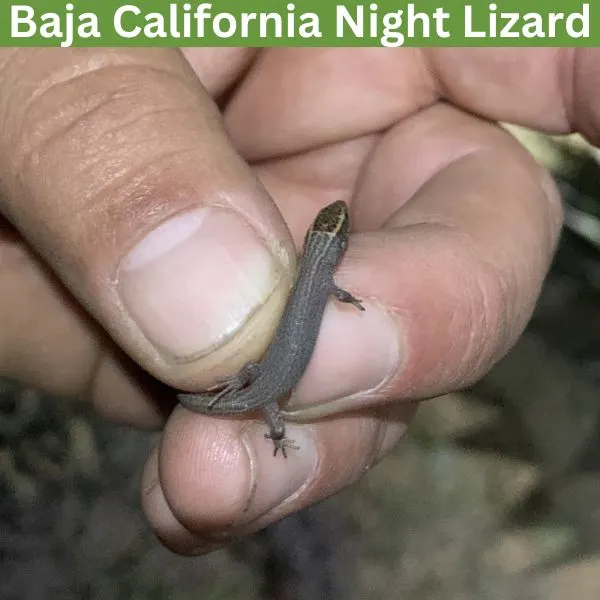
- Experience Level: Intermediate
- Family: Xantusiidae
- Scientific Name: Xantusia wigginsi
- Other Names: Wiggins Night Lizard
- Adult Size: 3 in. (7.62 cm.)
- Lifespan: 8 to 10 years
- Average Price Range: n/a
The rocky desserts within southern California near Scissors Crossing is where the Baja California lizard lives. This lizard is not seen often and is very secretive. They hide within desert scrub, and within plant life.
This lizard is small and thin, with smooth scales. They have gray, brown, a reddish coloring. A dark mottled pattern covers them, and they have a stripe running down their sides.
Small invertebrates are what this species eats. They are active in the day, but not seen often since they are very secretive. This lizard’s speed and secretive nature are what keep them protected from predators like birds.
39. Granite Night Lizard
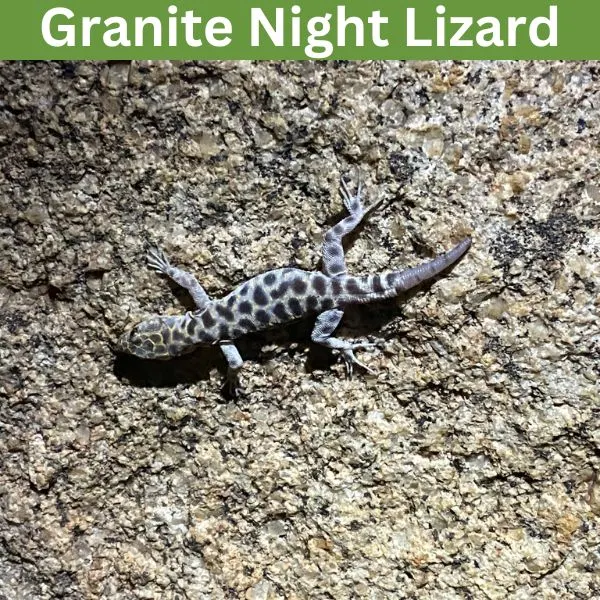
- Experience Level: Intermediate
- Family: Xantusiidae
- Scientific Name: Xantusia henshawi
- Other Names: n/a
- Adult Size: 3 to 5.2 in. (7.62 to 13 cm.)
- Lifespan: 8 to 10 years
- Average Price Range: n/a
The granite night lizard is a species found in the far southern California, with their range covering mainly in Baja California, Mexico. This species lives in rocky habitats and coastal scrubs. They are active mainly at night but may be seen in crevices during the day.
Granite night lizards have a flat head and body. They have dark brown, to black coloring, with a yellowish blotched pattern covering them. The eyes of this lizard are vertical. Their scales are small and smooth.
This species’ name is in honor of American naturalist Henry Wetherbee Henshaw. They have a stable population but are rare to see in California due to their small range.
40. Desert Night Lizard

- Experience Level: Intermediate
- Family: Xantusiidae
- Scientific Name: Xantusia vigilis
- Other Names: n/a
- Adult Size: 3 to 5.2 in. (7.62 to 13 cm.)
- Lifespan: 8 to 10 years
- Average Price Range: $300
Desert night lizards are native to southern California, and also found in other parts of the southwestern United States. This species lives in semi-arid habitats, and hide under rocks, and natural debris. They are common in yucca plants like Joshua trees and use these plants to hide from predators.
The desert night lizard has grey, brown, or olive color. They have a mottled pattern covering them, with small limbs, and very bumpy scales. Desert night lizards that are males are smaller.
This lizard is one of the few to give birth to live young. They have around 1 to 3 younglings and usually give birth in the fall. This species is active at night, but may sometimes be seen in the day.
41. Island Night Lizard
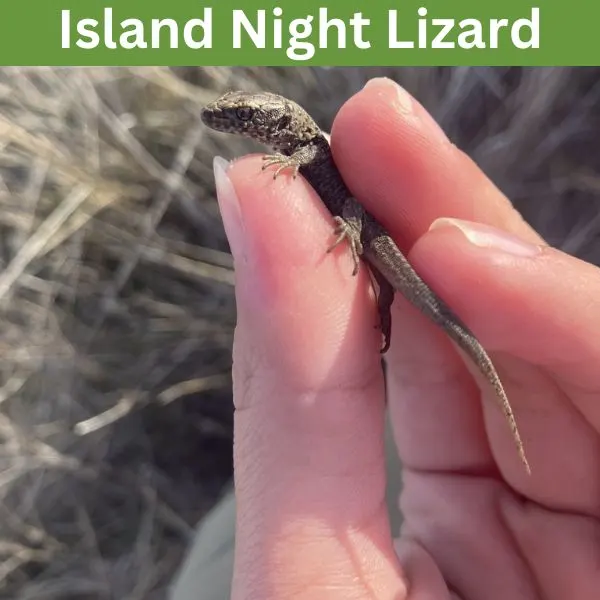
- Scientific Name: Xantusia riversiana
- Experience Level: Intermediate
- Family: Xantusiidae
- Other Names: n/a
- Adult Size: 2.6 to 4.3 in. (6.6 to 10.9 cm)
- Lifespan: 10 years
- Average Price Range: n/a
The island night lizard is found in coastal scrub habitats, and this species is native to the Channel islands in California. The population of this lizard is very small, and they are considered an at-risk species.
Island night lizards are small, with brown, beige, or black coloring. They can have blotches, stripes, or a mottled pattern that appears on them. The color of this lizard helps them blend into their habitats.
This lizard is considered vulnerable and is protected in the range. Island night lizards give birth to live young, instead of eggs. They hide in plants like cacti, and coastal scrub.
42. Sandstone Night Lizard
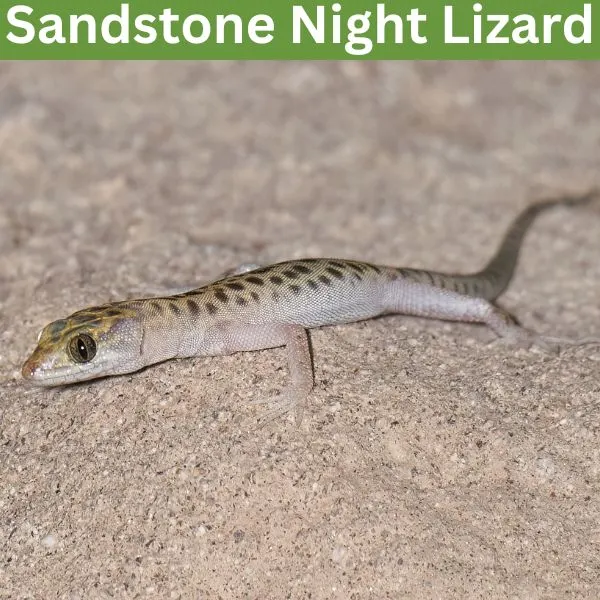
- Experience Level: Intermediate
- Family: Xantusiidae
- Scientific Name: Xantusia gracilis
- Other Names: n/a
- Adult Size: 2.6 to 4.3 in. (6.6 to 10.9 cm)
- Lifespan: 10 years
- Average Price Range: n/a
Sandstone night lizards are native to California, but this lizard species is extremely rare. They are only found in the Truckhaven Rocks in San Diego. Sandstone night lizards are a vulneragble species, and not seen often. Sandstone night lizards were once considered a subspecies of the granite night lizard, before being named as their own.
Sandstone night lizards are very small, with yellowish, or tan coloring. They have dark blotches on them, and a mottled pattern covering them. This species looks very similar to other night lizards and can be told apart from them by their range. Sandstone night lizards have bumpy skin with small scales and yellow eyes.
Night lizards like this species are not typically seen during the day and are more commonly spotted at night. Small insects and other invertebrates are what this species eats.
FAQ
Are there dangerous lizards in California?
The Gila monster is the only venomous lizard that lives in California, while the rest of the lizards that live in the state are relatively harmless. A lizard is painful, but not typically deadly. Gila monsters have venom that makes their bites more potent, but are rare in the state, and only found in the far southwestern corner of the state.
What is the largest lizard in California?
Chuckwallas and Gila monsters are the largest lizard species that live in California. Gila monsters are the largest and reach up to 22 inches in length. Other large lizards in the state include Alligator lizards and the desert iguanas. The species, sex, and age are what determines the how large a lizard gets.
In California are there invasive lizards?
California is home to a variety of invasive lizards, that have managed to establish populations within the state. Some invasive lizards in the state include the Rough-tailed gecko, Moorish gecko, and the Jacksons chameleon. The pet trade and shipments between countries are the most common ways lizards find their way into new regions.
Wrapping up
There are around 42 lizard species that live in California, and many of them have unique traits and lifestyles. Some species may make good pets for the reptile lover, but you should always research a species thoroughly before committing to owning one. If you considered getting one of the lizards in California as a pet you should never take it from the wild. Wild-caught lizards can have diseases and die quicker than one obtained from a trusted source.
Lizards are amazing, and essential parts of the ecosystems they live in. Some species in California are vulnerable and must be protected to prevent further population loss. The destruction of habitats and pollution are some of the main reasons why lizards can become vulnerable.
Learning about the lizards in California is one of the best ways to learn how to protect the various species that live in the state. California is home to countless beautiful wildlife and is home to some amazing lizard species.
Lizards in other states
